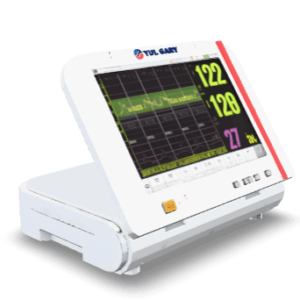Description
The Patient Monitors YG1671 // YG1673 are state-of-the-art medical equipment designed for precision and dependability, catering to healthcare professionals who require premium-quality patient monitoring in various environments. These monitors deliver real-time data on critical vital parameters such as ECG, heart rate, respiration rate, NIBP, SPO2, and temperature, making them essential in high-intensity areas like Intensive Care Units, operating rooms, and emergency departments. With an intuitive user interface featuring a large font display, healthcare providers can rapidly and accurately assess patient health, facilitating timely interventions and ultimately enhancing patient outcomes.
Market Price
In the competitive field of medical equipment, the YG1671 // YG1673 patient monitors are cost-effectively positioned. The price range for these advanced monitors generally falls between 700 USD and 1500 USD, which reflects their sophisticated features and widespread applicability in diverse healthcare settings.
Frequently Asked Questions
- What vital signs do the YG1671 // YG1673 monitor?
The monitors track a variety of critical signals, including ECG, heart rate, respiration rate, non-invasive blood pressure (NIBP), SPO2, and temperature, making them ideal for continuous monitoring in critical care environments.
- How does the OxyCRG dynamic view display improve patient care?
The OxyCRG dynamic view display provides real-time monitoring of oxygen saturation and cardiovascular status, essential for identifying potential issues in patients under anesthesia or with compromised respiratory or cardiac function.
- Can the YG1671 // YG1673 monitors be used in both stationary and mobile settings?
Yes, these monitors are designed with flexibility and portability in mind. They feature a rechargeable battery and AC/DC compatibility, ensuring they are suitable for both stationary and mobile applications in various healthcare environments.
Advantages and Disadvantages
Advantages:
- Comprehensive Monitoring: Provides robust monitoring of vital signs, including ECG, SPO2, heart rate, respiration, NIBP, and temperature, serving as a versatile tool for health professionals.
- Real-Time Data: Offers dynamic displays like OxyCRG and arrhythmia analysis, assisting clinicians in making timely, data-driven decisions.
- Portable and Flexible: With a rechargeable battery and AC/DC support, these monitors are ideal for both stationary and mobile healthcare settings, ensuring care continuity.
Disadvantages:
- Complexity for New Users: Although the big font interface aids readability, the comprehensive features may be overwhelming for less experienced users.
- Price Point: The advanced features and multi-parameter monitoring may come with a higher initial investment, potentially limiting access for smaller clinics or budget-conscious providers.
- Size: The units might be bulky for extremely tight spaces or certain mobile settings, possibly limiting adaptability for some practices.
Product Use in the Field
Ideal for critical care, the YG1671 // YG1673 monitors are pivotal in ICUs, operating rooms, and ambulatory units. They perform continuous monitoring of vital signs such as ECG, heart rate, SPO2, and respiration rate. Their capabilities in tracking ST segment changes and detecting arrhythmias are invaluable during procedures like anesthesia and cardiac surgeries, ensuring patient safety and facilitating swift clinical decisions.
Recommendations
For optimal performance of the YG1671 // YG1673 monitors, it is recommended to regularly calibrate NIBP and temperature sensors for accurate readings. Maintaining a clean display screen and electrodes is crucial to prevent interference with monitoring accuracy. Ensure the rechargeable battery is always charged for extended use, and leverage AC/DC compatibility for seamless operation in both stationary and mobile contexts.
Product Features
- Real-time monitoring and displays for comprehensive patient data analysis.
- User-friendly interface with a large font for easy readability in high-pressure scenarios.
- Flexible design with AC/DC compatibility suitable for both fixed and mobile healthcare environments.
- Ability to monitor multiple parameters concurrently for widespread clinical use.
Technical Specifications
| Model | YG1671 | YG1672 | YG1673 | |
| ECG | Lead mode | 5 Leads(RA,LA,LL,RL,V) | ||
| Connection method | I, II, III,AVR,AVL,AVF,V | |||
| Lead Mode | 3 Leads (RA,LA,LL) | |||
| Connection method | I, II,III | |||
| Waveform | 1ch | |||
| Gain | x250, x500, x1000, x2000 | |||
| HR Range | Adult: 15~300bpm | |||
| Neo/Ped | 15~350bpm | |||
| Accuracy | ±1% or ±1bpm | |||
| Resolution | 1bpm | |||
| Sensitivity | >200(uVp-p) | |||
| Differential input impedance | ≥5MΩ | |||
| ST segment Monitoring Range | ||||
| Measure Range | -2.0~+2.0mV | |||
| Measure Accuracy | -0.8mV~+0.8mV | |||
| Heart Rate | Measuring range | 0~350bpm | 20~300bpm | |
| Accuracy | ±1bpm | |||
| Resolution | 1bpm | |||
| Sensitivity | >200UVp-p | |||
| Respiration | Method | Impedance between R-F(RA-LL) | ||
| Differential Input Impedance | >2.5MΩ | |||
| Measuring Impedance Range | 0.3~3.0 MΩ | |||
| Base line Impedance Range | 200~4000Ω | |||
| Bandwidth | 0.1~2.5Hz | |||
| Resp. Rate | Adult: 2~120BrPM | |||
| Neo/Ped | 2~150BrPM | 0~150BrPM | ||
| Resolution | 1 BrPM | |||
| Accuracy | ±2 BrPM | |||
| Alarm | 10~40S | |||
| NIBP | Method | Oscillometric | ||
| Mode | Manual/Auto/STAT | |||
| Measuring Interval in AUTO Mode | 1,2,3,4,5,10,15,30,60,90,120,180,240,480(Min) | |||
| Measuring Period in STAT Mode | 5 Min | |||
| Pulse Rate Range | 40~240bpm | |||
| Alarm Type | SYS, DIA, MEAN | |||
| Resolution | ||||
| Pressure | 1mmHg | |||
| Accuracy | Maximum Mean error: 5mmHg | |||
| Maximum Standard deviation | 8mmHg | |||
| SPO2 | Display | Number of SPO2,waveform of capacity,Pulse | ||
| Measuring range | 0~100% | |||
| Resolution | 1% | |||
| Accuracy | 70~100% (±2%) | |||
| Alarm system | Audio-video alarm | |||
| Pulse rate range | 0~300bpm | |||
| TEMP | Channel | 2 | ||
| Measuring and Alarm Range | 0~50ºC | |||
| Resolution | 0.1ºC | |||
| Accuracy | 0.1ºC | |||
| Actualization interval | about 1 Second. | |||
| Average Time Constant | <10 Second. | |||



